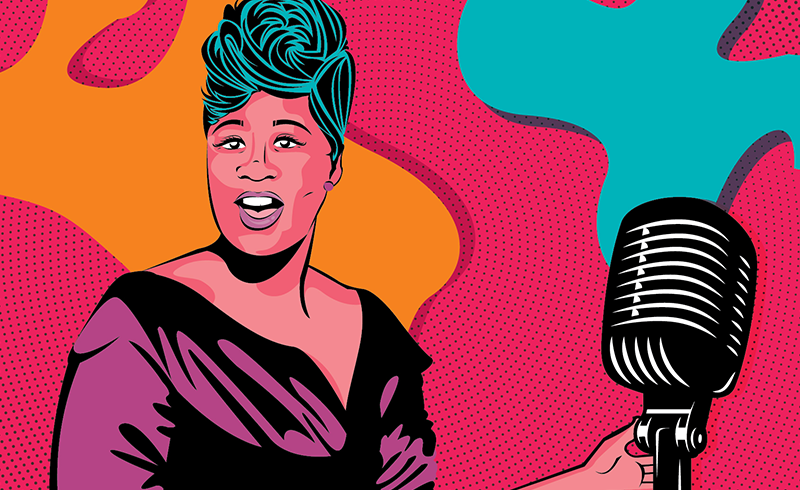
January 24, 2019
From Homeless to Household Name: Ella Fitzgerald’s Big Break
This Valentine’s Day weekend (February 15, 16 and 17), the Houston Symphony pays tribute to one of the greatest singers of the twentieth century: Ella Fitzgerald. Get tickets and more information about these concerts here.
While nearly everyone has heard of Ella Fitzgerald, few know of the remarkable path she took to become a legend of jazz and popular music whose influence resonates to this day. Ella was born in 1917 to poor parents in Newport News, Virginia, and Ella’s father left the family when she was only three years old. Like so many other people of color during this era, the Fitzgeralds took part in the great migration, moving north to Yonkers, New York in search of a better life. Life in Yonkers remained difficult, but Ella always had an irrepressible spirit; her neighbors and childhood friends would remember her as always singing and dancing, determined that one day she would be a star.
Initially, Ella did well in school, sang at church, took piano lessons and learned to read music. Her mother’s unexpected death in 1932, however, began a series of incredible hardships for the teenage girl. Possibly as a result of abuse from her stepfather, Ella moved to Harlem with her aunt. She did not adjust well to her new reality and dropped out of school, “running numbers”—selling tickets for an illegal, Mafia-run lottery—to make money. As a result of her truancy, she was sent to the New York State Training School for Girls, an institution for “wayward” or “incorrigible” young women. Two years later, a government investigation would expose that the black girls living at the school were housed in atrocious conditions and were routinely beaten. Understandably, Ella ran away. She was now homeless.
Beating the Odds

Despite these challenges, Ella was still singing and dancing. She regularly performed on 125th street in Harlem, and on November 21, 1934, she took part in the amateur night contest at the Apollo Theater. Originally, she had planned to dance, but when she saw the beautiful costumes of the other dancers she was so ashamed of her shabby clothes that she decided to sing instead at the last minute. Despite her unkempt hair and worn out boots, the audience went wild. She won the contest.
Ella’s victory did not immediately translate into an improvement in her living conditions, however; it was only four months later that she got her big break from Chick Webb, a young, ambitious band leader who had gained a reputation as one of the best drummers in Harlem. Despite his chronic spinal tuberculosis, which gave him a hunch-backed appearance, Webb was, like Ella, determined to break through to the big time. In 1935, he decided that maybe what his band needed was a female vocalist, and he tasked Charles Linton, his band’s handsome lead singer, with the task of finding him one. Linton explained that “They left it to me because they knew I knew all the women that were, well, you know, beautiful.”
The singer Linton found, however, was not what Webb initially had in mind. On a tip from an acquaintance who knew of Ella’s win at the Apollo, Linton went to visit her and heard her sing. Despite her appearance, Linton knew she was something special. He brought her to Webb, who took one look at her and whispered, “You’re not puttin’ that on my bandstand. No, no, no. Out!” Undeterred, Linton turned to Webb’s manager Charlie Buchanan, and threatened to quit if he refused to listen to her. After a trial of two weeks, Webb made Ella his lead female vocalist.
The Voice of the Century
Within months of being homeless, the 18-year-old singer would become one of the most sought after artists in Harlem, and by 1938 she had her first chart-topping hit. Her first recordings already reveal the remarkable vocal qualities that would make her “The First Lady of Song.” Her intonation and diction were flawless; she had an innate feeling for rhythm and could swing effortlessly; she could memorize the words and melodies of new songs at an astonishing speed; she had a range of three octaves and a gift for improvisation and scat singing; and her voice had a disarmingly lovely, youthful tone. But perhaps most of all, even at 18 she sang with joy and an emotional maturity beyond her years. She knew how to take life, with all its adversity, and turn it into something beautiful. In the midst of the Great Depression, that was exactly what America needed.
https://www.youtube.com/watch?v=FCUCV9oUnvY
Ella’s nearly 60-year career would set records and break boundaries, and in honor of her extraordinary accomplishments the Houston Symphony has gathered together some of her most talented admirers for a program of her signature songs. Featuring classics by George Gershwin, Count Basie, Cab Calloway, Richard Rodgers and more, these concerts showcase the romance and jazzy vocal fireworks of Ella’s repertoire. The concerts’ vocalists, Montego Glover, Capathia Jenkens and N’Kenge, are all Broadway veterans who have starred in shows such as Memphis, Motown: The Musical and Les Misérables, and will be backed up by Principal Pops Conductor Steven Reineke and the fabulous musicians of the Houston Symphony.
“She is my personal favorite ‘girl singer’ of all time,” Steven said. “Not only was she one of the greatest jazz singers, male or female, but her repertoire is full of extraordinary songs. I’m not often star-struck any more, but I would give just about anything to have met Ella or to have seen her perform.”
Don’t miss The Ella Fitzgerald Songbook February 15, 16 & 17, 2019! Get tickets and more information at houstonsymphony.org.






